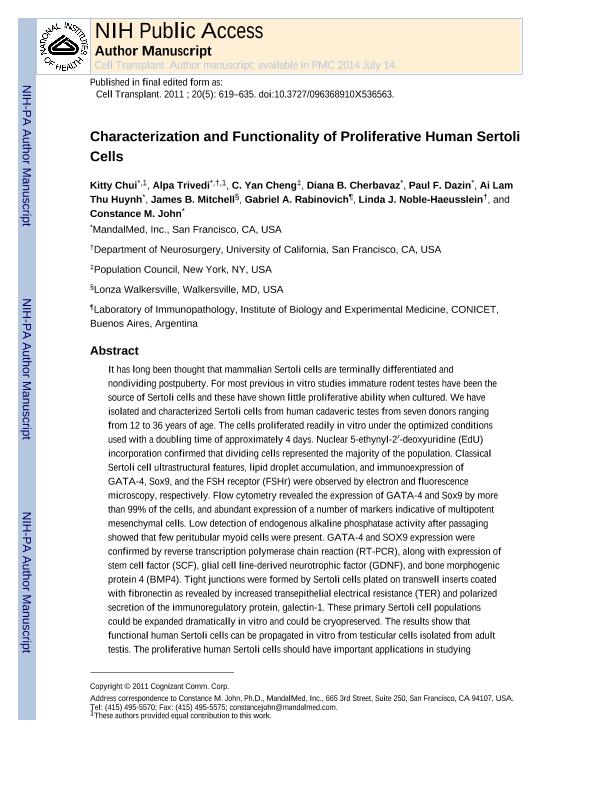Artículo
Characterization and functionality of proliferative human sertoli cells
Chui, Kitty; Trivedi, Alpa; Cheng, C. Yan; Cherbavaz, Diana B.; Dazin, Paul F.; Huynh, Ai Lam Thu; Mitchel, James B.; Rabinovich, Gabriel Adrián ; Noble Haeusslein, Linda J.; John, Constance M.
; Noble Haeusslein, Linda J.; John, Constance M.
 ; Noble Haeusslein, Linda J.; John, Constance M.
; Noble Haeusslein, Linda J.; John, Constance M.
Fecha de publicación:
05/2011
Editorial:
Cognizant Communication Corp
Revista:
Cell Transplantation
ISSN:
0963-6897
e-ISSN:
1555-3892
Idioma:
Inglés
Tipo de recurso:
Artículo publicado
Clasificación temática:
Resumen
It has long been thought that mammalian Sertoli cells are terminally differentiated and nondividing postpuberty. For most previous in vitro studies immature rodent testes have been the source of Sertoli cells and these have shown little proliferative ability when cultured. We have isolated and characterized Sertoli cells from human cadaveric testes from seven donors ranging from 12 to 36 years of age. The cells proliferated readily in vitro under the optimized conditions used with a doubling time of approximately 4 days. Nuclear 5-ethynyl-2´-deoxyuridine (EdU) incorporation confirmed that dividing cells represented the majority of the population. Classical Sertoli cell ultrastructural features, lipid droplet accumulation, and immunoexpression of GATA-4, Sox9, and the FSH receptor (FSHr) were observed by electron and fluorescence microscopy, respectively. Flow cytometry revealed the expression of GATA-4 and Sox9 by more than 99% of the cells, and abundant expression of a number of markers indicative of multipotent mesenchymal cells. Low detection of endogenous alkaline phosphatase activity after passaging showed that few peritubular myoid cells were present. GATA-4 and SOX9 expression were confirmed by reverse transcription polymerase chain reaction (RT-PCR), along with expression of stem cell factor (SCF), glial cell line-derived neurotrophic factor (GDNF), and bone morphogenic protein 4 (BMP4). Tight junctions were formed by Sertoli cells plated on transwell inserts coated with fibronectin as revealed by increased transepithelial electrical resistance (TER) and polarized secretion of the immunoregulatory protein, galectin-1. These primary Sertoli cell populations could be expanded dramatically in vitro and could be cryopreserved. The results show that functional human Sertoli cells can be propagated in vitro from testicular cells isolated from adult testis. The proliferative human Sertoli cells should have important applications in studying infertility, reproductive toxicology, testicular cancer, and spermatogenesis, and due to their unique biological properties potentially could be useful in cell therapy.
Palabras clave:
Sertoli Cells
,
Proliferation
,
Cell Cycle
,
Galectins
Archivos asociados
Licencia
Identificadores
Colecciones
Articulos(IBYME)
Articulos de INST.DE BIOLOGIA Y MEDICINA EXPERIMENTAL (I)
Articulos de INST.DE BIOLOGIA Y MEDICINA EXPERIMENTAL (I)
Citación
Chui, Kitty; Trivedi, Alpa; Cheng, C. Yan; Cherbavaz, Diana B.; Dazin, Paul F.; et al.; Characterization and functionality of proliferative human sertoli cells; Cognizant Communication Corp; Cell Transplantation; 20; 5; 5-2011; 619-635
Compartir
Altmétricas



